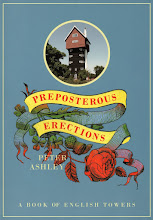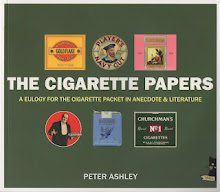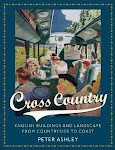skip to main |
skip to sidebar
Game of Two Halves

 Fitton End is only three miles from Wisbech, a handful of houses including the derelict Fitton Hall that looks like a gothic railway station marooned in the fields. You won't find the hall in Pevsner or a Shell Guide, but it's certainly worth a look before it gets restored. But it wasn't what made me turn round in a farmyard and retrace my tyre marks. At first glance this pair of cottages look nothing out of the ordinary, the left hand dwelling still almost original. But on looking more closely I thought 'Voysey'. Charles Francis Annesley Voysey (1857-1941) was a leading member of the Arts & Crafts movement, and is famous for his country houses that, although large, were never grand. His trademarks were pebble-dashing, angled buttresses, porthole windows. And he designed everything from the wallpaper to the knives and forks. This pair of semi-detacheds aren't by him, far from it, but there is certainly a Voysey-inspired architectural game going on here. Out on the fen I see the landowner at breakfast at the Hall, reading Building News and, on seeing a Voysey retrospective, turning down the page corner for a later chat with his estate manager. Rose Cottage maybe painted-up like a lighthouse, but I think Voysey would have loved it.
Fitton End is only three miles from Wisbech, a handful of houses including the derelict Fitton Hall that looks like a gothic railway station marooned in the fields. You won't find the hall in Pevsner or a Shell Guide, but it's certainly worth a look before it gets restored. But it wasn't what made me turn round in a farmyard and retrace my tyre marks. At first glance this pair of cottages look nothing out of the ordinary, the left hand dwelling still almost original. But on looking more closely I thought 'Voysey'. Charles Francis Annesley Voysey (1857-1941) was a leading member of the Arts & Crafts movement, and is famous for his country houses that, although large, were never grand. His trademarks were pebble-dashing, angled buttresses, porthole windows. And he designed everything from the wallpaper to the knives and forks. This pair of semi-detacheds aren't by him, far from it, but there is certainly a Voysey-inspired architectural game going on here. Out on the fen I see the landowner at breakfast at the Hall, reading Building News and, on seeing a Voysey retrospective, turning down the page corner for a later chat with his estate manager. Rose Cottage maybe painted-up like a lighthouse, but I think Voysey would have loved it.

 Fitton End is only three miles from Wisbech, a handful of houses including the derelict Fitton Hall that looks like a gothic railway station marooned in the fields. You won't find the hall in Pevsner or a Shell Guide, but it's certainly worth a look before it gets restored. But it wasn't what made me turn round in a farmyard and retrace my tyre marks. At first glance this pair of cottages look nothing out of the ordinary, the left hand dwelling still almost original. But on looking more closely I thought 'Voysey'. Charles Francis Annesley Voysey (1857-1941) was a leading member of the Arts & Crafts movement, and is famous for his country houses that, although large, were never grand. His trademarks were pebble-dashing, angled buttresses, porthole windows. And he designed everything from the wallpaper to the knives and forks. This pair of semi-detacheds aren't by him, far from it, but there is certainly a Voysey-inspired architectural game going on here. Out on the fen I see the landowner at breakfast at the Hall, reading Building News and, on seeing a Voysey retrospective, turning down the page corner for a later chat with his estate manager. Rose Cottage maybe painted-up like a lighthouse, but I think Voysey would have loved it.
Fitton End is only three miles from Wisbech, a handful of houses including the derelict Fitton Hall that looks like a gothic railway station marooned in the fields. You won't find the hall in Pevsner or a Shell Guide, but it's certainly worth a look before it gets restored. But it wasn't what made me turn round in a farmyard and retrace my tyre marks. At first glance this pair of cottages look nothing out of the ordinary, the left hand dwelling still almost original. But on looking more closely I thought 'Voysey'. Charles Francis Annesley Voysey (1857-1941) was a leading member of the Arts & Crafts movement, and is famous for his country houses that, although large, were never grand. His trademarks were pebble-dashing, angled buttresses, porthole windows. And he designed everything from the wallpaper to the knives and forks. This pair of semi-detacheds aren't by him, far from it, but there is certainly a Voysey-inspired architectural game going on here. Out on the fen I see the landowner at breakfast at the Hall, reading Building News and, on seeing a Voysey retrospective, turning down the page corner for a later chat with his estate manager. Rose Cottage maybe painted-up like a lighthouse, but I think Voysey would have loved it. 






3 comments:
Is that verdigris above the window and on the drainpipe on West Side Cottage? Lovely.
Funny how Arts And Crafts buildings pop up in unexpected places. Down the road from us in Leyton is the lovely Fetter Lane Chapel by P. Morley-Horder. In those down-at-heel backstreets it stands out like Erin O'Connor on a group photograph of Jade Goody and friends.
Hadn't spotted the verdigris Ten Inch. And thanks for the outrageously-accurate analogy for stand-out buildings.
You'll find the influence of Voysey in various suburban housing developments across London, from Muswell Hill to Chislehurst. Add a dash of Norman Shaw and a whiff of Hampstead Garden Suburb and you get some of the better council estates of the interwar years – although here the influences are diluted somewhat.
Post a Comment